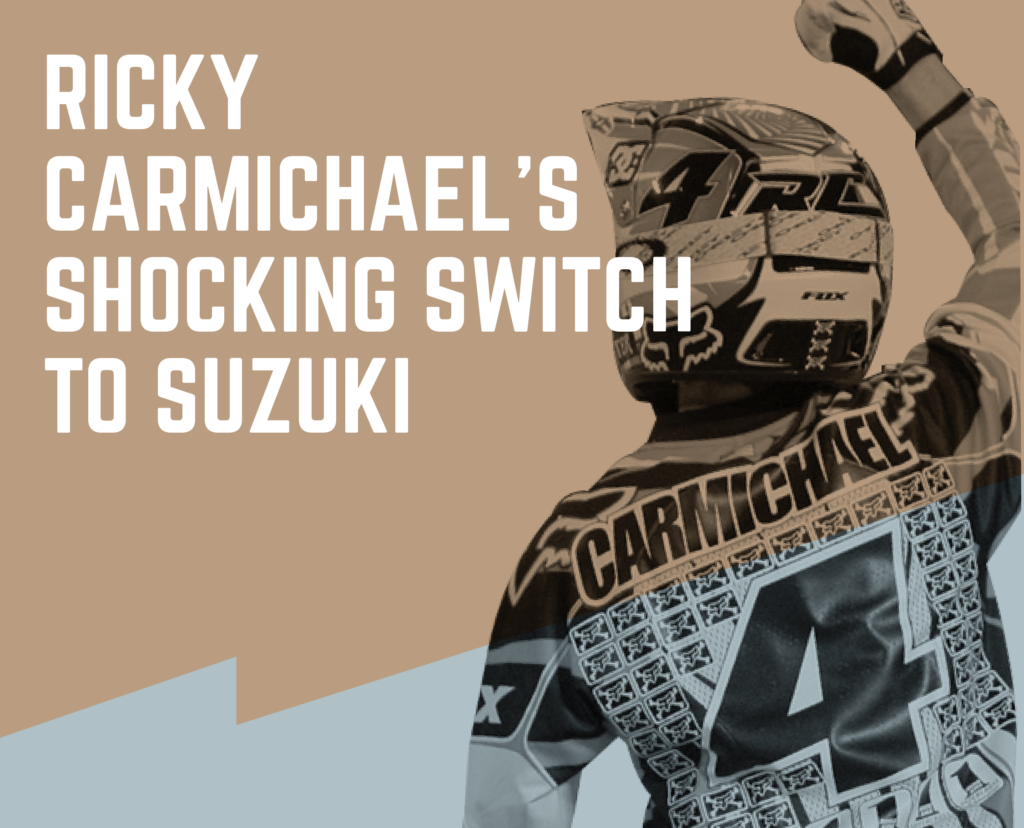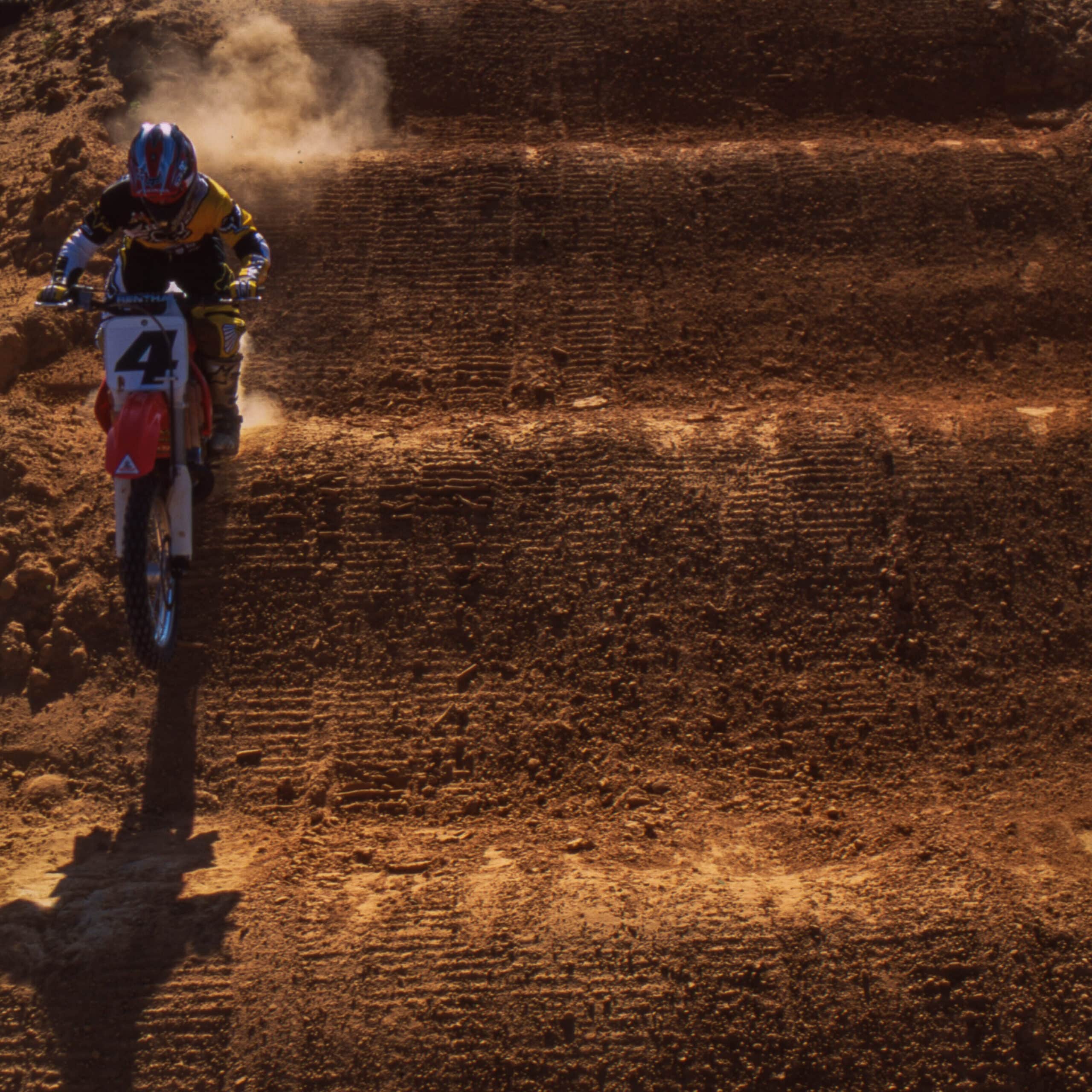
Part 5: Carmichael is on to ‘thumping’ but injury derails his season
Like that feel-good training montage scene from a sports movie, they all stared at their stopwatches with widened eyes. Then they looked at each other in surprise. Ricky was always on the clock. His people timed every single lap he rode, even when he wasn’t riding his own bike.
His mechanic, Mike Gosselaar, riding coach, Johnny O’Mara and his trainer, Aldon Baker huddled together, each holding a stopwatch in their hands. “That can’t be right,” one of them said.

“Did you get…?” another said.
“But it doesn’t look like he’s going that fast.”
They let Carmichael continue circulating. Same thing. It was November 21, a Friday afternoon, a typical warm, sunny Corona, California day. Carmichael and his crew had spent the week testing at Honda’s Supercross track high above the eastern side of the valley. For this important session, O’Mara lobbied hard to have the engineer who had developed the motor in Honda’s CR250R two stroke sent over from Japan. They wanted more bottom end out of the bike.
FAST TRIVIA
In the championship era of AMA Supercross (1974-present), who was the first rider to win a main event on a Honda?
Carmichael thought he could find something because he had ridden Mike Brown’s Yamaha YZ250 earlier that fall and loved it. If he could get his Honda motor closer to that of the Yamaha, then winning in 2004 would be a hell of a lot easier than it was in 2003. He still had bitter feelings about getting beaten by Reed at the end of the 2003 AMA Supercross series.
Even though he won the championship by seven points, Carmichael finished second to Reed in the final six races of the series. Reed, Carmichael and his Honda teammate Ernesto Fonseca went 1-2-3 at St. Louis, Houston, Pontiac, Irving, Salt Lake City and Las Vegas.
Honda of Japan announced the end of two stroke development that same year, however. Model year 2007, the company announced, would be the final year of two stroke production in its motorcycle line.

After days of swapping parts and settings, improvements did not materialize. They had reached the limits of that motor design. According to O’Mara, the engineer said, “It’s time to go to the four stroke.” As the sun dipped into the Temescal Mountains, Carmichael mounted Kevin Windham’s 450 and headed onto the dry and worn out track, hammered from the week of abuse.
“It was instantly faster,” O’Mara says. Their stopwatches all indicated that their rider’s lap times, on a track much rougher than it was earlier in the morning, were one and a half to two seconds faster.
“It was a big, like, ‘holy smokes, did I get my lap times wrong?” Baker remembers. “And it looked easy, too. It looked like he was hardly trying.”
Gosselaar was both giddy and groaning. They had confirmed all their settings and parts for a new season that started in six weeks. For him, it meant starting over. Few, if any, settings transferred from the two stroke to the four stroke and Gosselaar had spent 10 years working only on the former. Right there, Carmichael made the decision to race the Honda CRF450R in Supercross in 2004. He’d never say this out loud but in his head he thought it could be the easiest title he ever won.

He extended his California trip and scheduled another test session early the following week. For a change of scenery, he rented the track at Castillo Ranch, 200 miles northwest of Corona. Gosselaar spent the weekend building up a 450 for his rider.
O’Mara and Carmichael drove up to Central California together in a van and met the small gathering of Honda personnel. Flanked by rolling green hills, the postcard perfect track had been a featured setting in the riding videos of Carmichael’s youth. If any footage was shot on this day, it can’t be more than a few minutes long because the session ended before anyone had a chance to find the stopwatches.
During a warm up lap, Carmichael said his knee popped out while jumping through a rhythm section. He didn’t crash but felt unbearable pain and he rode back to the Honda box van in tears.
“I was emotional as hell,” he says. “I was crying, and these guys have never seen me crying.” He had to be lifted off the seat of the bike. Of the crew at Castillo, only O’Mara and Gosselaar were aware of the torn ACL and the plan to ride through it.
I was emotional as hell. I was crying, and these guys have never seen me crying.
Ricky Carmichael
Carmichael confessed. “We’re done, boys,” he told everyone at the box van. “And that was it. It was just crickets.”
In addition to the physical pain, he felt horrible about the logistical consequences; the hours spent developing bikes and parts, planning schedules, the people whose working lives centered around helping him win. That immediately stopped because he already knew the problem, the solution and lengthy recovery period that followed.

“It was one of the heaviest things that I ever had to endure,” he says.
The 2004 AMA Pro Motocross season was less than six months away. Time was so precious that O’Mara arranged for a private plane owned by Oakley’s founder, Jim Jannard to transport Carmichael from California to Lexington, Kentucky where he was examined by orthopedic surgeon Dr. Rick Lyon. The meniscus was–there was no meniscus. The pain he felt wasn’t just his patella shifting around, it was his tibia and femur knocking together hard enough to destroy one another.
“I chipped the top of my femur bone off,” Carmichael says. “Imagine swinging a golf club and you take a divot out of the grass. I took a divot out of the top of my femur bone.”
The calendar Ricky’s mother used to keep track of her son’s whereabouts and where she made almost microscopic shorthand notes about lap times and training has two giant words written in pencil for Tuesday, November 25, 2003: “RICKY HURT.”

The next day, Honda announced Carmichael’s injury and withdrawal from the upcoming Supercross series. Carmichael celebrated both Thanksgiving and his 24th birthday at home in Tallahassee and waited for the swelling to subside in his left knee. He had surgery on December 9. In the moment, he was devastated. In hindsight, it was the best happy accident of his racing career.
“I feel that saved his career and extended it,” Baker says. “I felt like Ricky was borderline worn out. Never mind all those test days. They’ll wear anybody out.”
The forced downtime would have been a lot more palatable, however, if his future was secured. Carmichael and Honda still had not finalized a new agreement and now he felt his negotiating position was severely weakened.